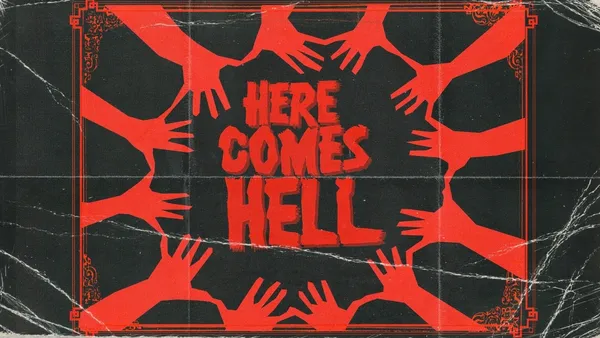 |
| Put your hands together for Here Comes Hell |
One dark night in a crumbling mansion in a remote part of the English countryside, a group of friends gathers for a dinner party. They seem to have quite enough intrigue, suppressed passion and overt bitterness to keep themselves occupied all night, but the host decides that what would really liven things up would be a séance. The house, however, was once the home of a sinister sorcerer, and the party’s dabbling turns a quiet weekend away into the holiday from Hell.
Show in black and white in a 1930s style, Jack McHenry’s directorial début Here Comes Hell has been described as ‘Downton Abbey meets The Evil Dead and will appeal to fans of both. It’s set to screen in the Frightfest strand at this year’s Glasgow Film Festival and in anticipation of that, Jack and one of his stars, Margaret Clunie, spoke with me about how it was made.
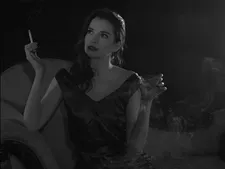 |
| Margaret Clunie in Here Comes Hell |
“I’ve always really loved films like Evil Dead and those kind of Eighties movies like John Carpenter’s The Thing,” says Jack, “and I always wanted to make a horror movie but at the same time I’ve always enjoyed reading, like, Agatha Christie novels and the characters in those stories, of the the clichés, the sort of things you get from Cluedo. I always thought it would be kind of interesting to combine the two mixtures of genres.
“For example, the best example would be Blithe Spirit, the film, because there’s a séance halfway through that. I was watching that and what would happen if that séance happened and instead of it continuing as a farce the genre switched and turned into full horror. And also I’m a fan of older movies and this allowed us to make a film using old fashioned techniques like model-making and in-camera effects, which I always loved and I feel aren’t really used enough in contemporary cinema.”
Did that factor into the way the film was shot?
“Yeah. That was a really big part of it. We really tried to make it look as authentic as possible. In the first half we used as many wide shots as possible, and then in the second half where it turns more anarchic, that was very different camerawork.”
“For the actual effects they made puppets and there was a lot of fake blood being thrown literally at me,” says Margaret, laughing. “It was a really interesting way to make a film.”
How did she get involved with the project?
“I am an old friend of Jack’s,” she explains. “We’ve done a couple of short films together before. I suppose I’ve known Jack for about ten years!” They both laugh. “I live literally five minutes round the corner,” she continues. “We look after each other’s cats when we go on holiday.”
“I was going to say, we feed each other’s cats,” says Jack. “Me and my girlfriend Alice [Sidgwick], who I live with, we wrote Margaret’s character with her in mind from the beginning. With low budget films it’s always useful to think of characters or people you know.”
Was it written with that limited budget in mind?
“We should have thought about that a bit more!” Jack says, and they laugh. “We wrote it kind of crazily and then we were like ‘Right, how do we do it?’ We should have done it the other way round!”
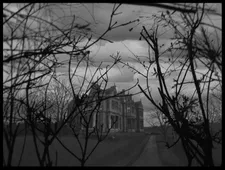 |
| The old dark house Photo: FrightFest |
Margaret agrees.
“Luckily I still feel we managed to pull off everything we wanted for it,” says Jack. “Shooting in that old black and white style allowed us to... it played into it, if you like. If things didn’t look quite right that worked in our favour.”
“It heightened the old fashioned style,” says Margaret.
“Yeah. the heightened reality of the film.”
I ask if they shot in house or built sets, and Margaret explains that they had access to a real house. “We did ten days straight shooting. It was kind of insane but we smashed through it and I think we got everything we needed.”
“Yeah,” says Jack. “I was shot in two chunks, first in the big old house which – well, it was this time last year, basically, it was January – so it was very cold. It was freezing! It was snowing and there were big chunks of the house where...”
“If you went upstairs,” Margaret interjects, “the guy that owned it said ‘Oh, it’s only one person on the staircase at a time. If you go upstairs don’t turn left – you’ll fall through the floor and probably die.”
“It was very scary sometimes!” says Jack. “But we were in the house itself that that was a massive thing. We spent ages looking for a house like that. It sounds clichéd but we needed it to be a character in the film. Luckily we found this house and t was amazing and that’s how we managed to give it this production value. Without that we wouldn’t have been able to pull it off. And it had all the wallpaper and stuff. It had such texture and grime to it, that adds so much to it. That was our first ten days chunk shooting. Then we took a break from it and then we did a few shots over weekends from February onwards until, was it March?”
“I know it was quite long,” says Margaret, “because Taz [Tom Bailey] who plays the American had to have a little goatee and he kept wanting to shave it off and Jack kept telling him to not shave it off for a very long time.”
“He kept on having to go around with this very elaborate moustache and beard,” says Jack, sounding more amused than remorseful.”
Did the location and the limited budget affect the way the film developed?
“Yes and no,” says Jack. “The actual structure of the film stayed very tight to the script, especially when we were shooting because it was such a tight schedule that we didn’t have a lot of time to play around with it, but I like to think that I let the actors...”
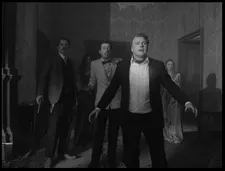 |
| Facing peril in Here Comes Hell Photo: Glasgow Film Festival |
“We had rehearsals,” puts i Margaret. “We had a great table read in October. We all went round to Jack’s house and he laid on a spread and we read the film by candlelight, and it was very cool.”
“They wee all meant to be old friends of related,” Jack notes, “so we wanted to have some sense that they might have hung out before. But then there are some elements at the end – the fog at the end, the tunnel sequence, was supposed to be more like The Descent, but we didn’t have enough money! So it really actually, I think, added to the film. It gave it a different, more psychedelic feel at the ending.”
Quite a few old films use that technique, I observe.
“Yeah, exactly. It added a totally different tone to the film. So that was one of the bigger things that changed but the actually story itself we pretty much stuck to.”
One of the few things that stands out as different from the old films that Here Comes Hall references is the complexity of the female characters and the way their actions drive the narrative. There’s not a ripped dress in sight.
Jack says that he certainly thought about that aspect of the film, adding “Me and Alice wanted to stick to almost the classic horror style. One it just never felt as if that should be in this kind of story, but also I didn’t want to objectify the characters.”
“It’s great from an actor’s point of view to play someone whose character trajectory flips so much,” says Margaret. “I mean, to begin with she’s a complete bitch but she changes. By the end she’s a very strong female character. It hasn’t ended up all being about the guys.”
“The whole idea was that at the beginning you build up these characters as clichés you might have seen before,” says Jack, “so the idea of George, who’s a Texan who does this cool cowboy act and almost could be an action hero character but when the film continues things change and then other characters who you might kind of like switch, and that was always the fun of the film, to play on these tropes and flip them.”
Margaret says that there were more rehearsals than she’s used to when preparing for films, which helped with building up the dynamic between the characters.
“While we were filming up at the house we were all staying in one house together,” adds Jack. “Like literally all sleeping on the floor.”
“We were in each other’s faces the whole day,” says Margaret. “Fortunately everyone got on very well.”
“So you couldn’t help but interact with each other,” says Jack. “We always had big dinners together and stuff, so that did help, I think. Because we were like one big travelling circus.”
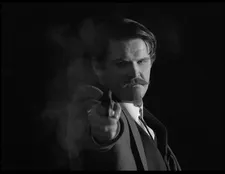 |
| An American take on dealing with evil Photo: FrightFest |
We discuss the production process and I ask if they had any favourite moments.
Jack goes first. “Probably – because this is my first feature film and my biggest project – just filming the actors and being with them for ten days. It was great just to watch them take on these characters and roll with them... Filming the dialogue scenes at the dinner table was really exciting because I actually saw this movie coming to life.”
“I don’t think I’ve played any character where I’ve got to handle so many different kinds of weapon,” says Margaret happily. “Everyone was very enthusiastic about all the sorts of swords and guns when they were on set – they weren’t real guns, obviously – and we watched outtakes every evening and everyone was just loving it when Taz had his gun and had to do a load of quick fire. I get a sword at one point which was great although it was very heavy, and I think I got to fire the blunderbuss at one point.”
Jack confirms this.
“And I think I had another gun at another point.”
“There were a lot of different guns.”
“I felt like a real badass walking around with a sword,” Margaret laughs.
How did they handle the fighting and the practical effects when they had so little shooting time overall?
“I think there were a couple of shots where it was a one take wonder and you just had to go for it,” recalls Margaret.
“Yeah,” says Jack. “We were kind of running in between set-ups at some points because we could only be in the house from a certain point to a certain point in the evening so there were times when we were like ‘Wet got it. Go!’”
“Go, go, go, go!” adds Margaret enthusiastically.
“But I do think,” Jack continues, “having these puppets and in-camera effects were great. I was looking through the monitor because I was editing it as well and I was like’ Yeah, we’ve got it, we can move on.’ Because we weren’t doing stuff in post but i could see it and work out where we could cut around it in post. So it was a real blend of the old and new technology.”
And avoiding spoilers, do they have favourite scenes?
“I think my favourite is probably the middle scene, the séance scene,” says Jack. “That was fun to shoot as well actually.”
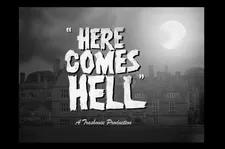 |
| Coming to the big screen at last - but dare you watch? |
Margaret agrees. “There was a dolly that was going round the table...”
“Which was actually a wheelchair,” Jack admits.”But t did look like a dolly shot.”
Margaret queries the origins of the wheelchair and Jack says that they found it at the location.
“I did also like doing the fog scene,” he says. “That was kind of an intense day.”
“We inhaled so much!” adds Margaret. “It can’t be good for you! Oh well, it was worth it.”
What’s next for the two of them?
“I am currently writing a project,” says Jack. “It’s kind of a Medieval adventure movie so hopefully we’ll be ale to get that in production. It’s like Die Hard in Medieval times.”
Margaret laughs. “I’ve just wrapped on a very small part in a Christmas film, which was great. And I’m doing a short film with an old friend who I’ve done lots of things before with, next week, which I’m really looking forward to as well.”
And finally, how do they feel about the film being selected for Frightfest Glasgow?
“That was amazing,” says Jack. “That was so cool, hearing about that, because that was really always the goal, to get it into festivals like that. That is like the best festival for these kinds of films because they’re just great audiences and they’re so open minded, and I am a fan of horror movies so it’s kind of like the home of these kind of genre movies, so really excited and hopefully the audience likes it.”
They agree that they’re looking forward to attending the festival “and soaking up all the blood.”
Here Comes Hell screens in Glasgow on Friday 1 March.





















